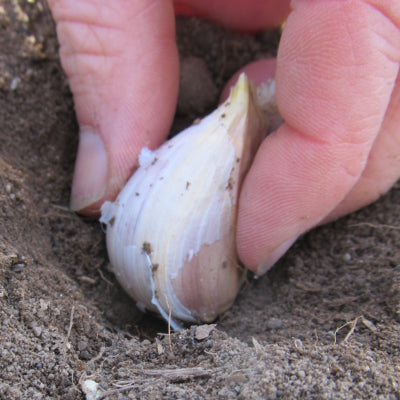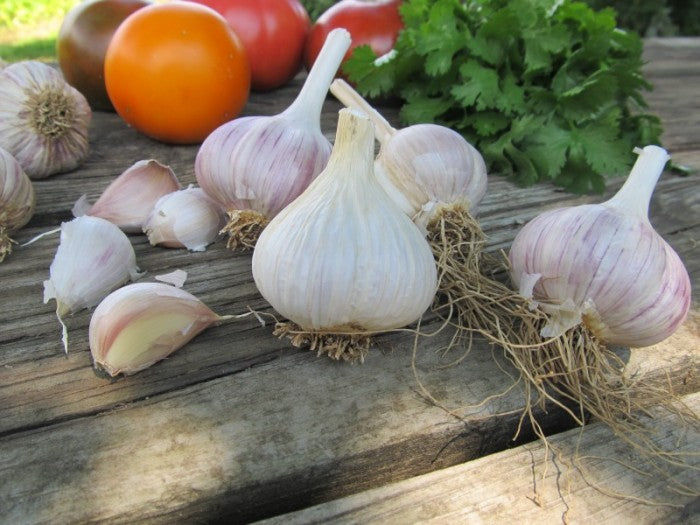Here in the Northeast we often think of there being a short growing season. In other regions, many folks garden as if there's a beginning and an end as well. But gardening, anywhere you do it, is circular. There may be slow times, but planning ahead for what's around the bend is crucial. Right now we're thinking about next year's garlic. Here we are, another turn of the season. Soon (but hopefully not too soon!), cool days and nights will be creeping in. Although it's too early to be pulling out the sweaters, cooking warm soup, and tucking-in the garden, it's not too soon to think about the golden age of the year: fall. In addition to the annual clean up and "tuck-in," autumn is the best time of year to take notes, reflect on mistakes and successes, and enjoy the last gasps of warmth and sun.
So, it's really quite wonderful that one of the last planting tasks in the garden is getting garlic in the ground. Planting in general may feel counter to all the other fall tasks, but when you plant garlic you are "putting it to bed," since it needs a cold cycle to perform well. On the other hand, the very act of planting--looking forward to spring and summer and harvest--brings the cycle of the seasons together quite nicely, proving that a garden never begins or ends; it only changes.
Quantity
How much you plant depends on what you want out of your crop.
The shortest answer is that 1 pound can plant between 15 and 30 feet depending on the variety, and the amount of space you give it. (That's a single row. Space rows 12 inches apart in whatever bed system you use.)
If you would like to produce your own seed stock and your own eating stock, plan to reserve the top 30% of your harvest for planting. Each pound of garlic can produce between 50-75 heads of garlic, since each clove can produce a head.
Location
Since we follow a vegetable rotation, we know where our garlic will be well ahead of planting time. This gives us a chance to make sure the beds are well-worked, weeded, amended and prepared.
Here's what you need to consider. Plan ahead a few weeks before your planting date:
 1. First, pick your site. Garlic prefers rich, well-drained, and weed-free soil located in full sun. Ideally, pick a spot that is in full sun from winter through spring. It can be difficult to grow a crop in your weediest beds, so consider this when location scouting during the summer.
1. First, pick your site. Garlic prefers rich, well-drained, and weed-free soil located in full sun. Ideally, pick a spot that is in full sun from winter through spring. It can be difficult to grow a crop in your weediest beds, so consider this when location scouting during the summer.
2. Consider your mulching options. Compost, aged manure, and weed-free hay or straw mulch are good choices. Give yourself plenty of time to get this figured out--don't leave it for later lest you forget!
3. A few days prior to planting, prep your site. Visit our bed prep post for tips on how to get a good, even garden bed.
Planting Garlic
Pick a sunny day in early to mid-October, when the soil is still warm. Try to leave enough time before the ground freezes solid for the garlic to set roots. (Garlic can be planted any time before the ground freezes solid, though, ideally 3-6 weeks prior.)
Begin by breaking apart the heads of garlic into cloves. Count the cloves and determine the amount of space you need. Most hardneck varieties have 50-90 cloves per pound. Garlic prefers full sun, so choose a spot that will get full sun for the spring and early summer. Each clove will be planted at 6" spacing, in rows 12" apart. Weed and work a proper amount of garden space. After cultivating the space, mark the rows. Plant cloves root side down, 2" deep, at least 6" apart, in rows 12" apart. Water and cover with mulch. Your garlic will need to be tended to in the spring, once the ground warms and it begins to grow.
Spring growing conditions and care: Garlic begins to poke through the ground as soon as the soil warms. If you covered your garlic with a thick mulch layer, rake it back to help warm the soil faster.
Garlic prefers rich, weed-free soil and ample water. Beginning in the spring, pull weeds when small, taking care not to damage your garlic when pulling them out. Hardneck varieties produce garlic scapes in the spring. If left on the plant, the scapes will draw energy from the bulb, reducing size and quality. Once the scapes emerge, cut them off immediately to direct the plants' energy into bulb production. The scapes are an edible spring delicacy.
Fertility: Giving your garlic a nutrient boost in the early spring is highly recommended. Garlic performs well with a nitrogen boost in the form of alfalfa meal, or a light side-dress of compost.






